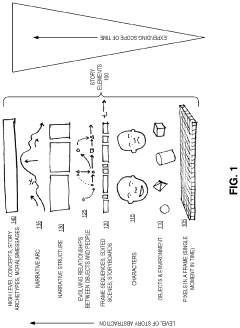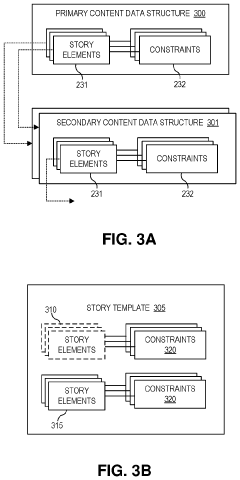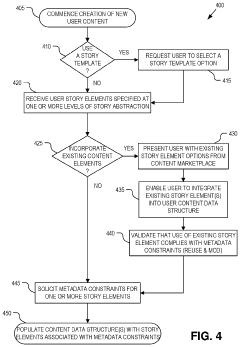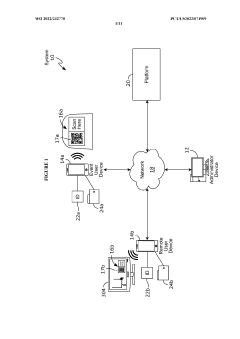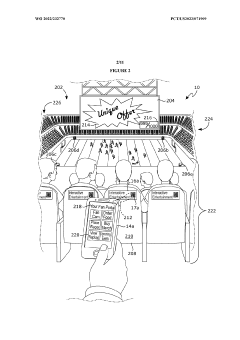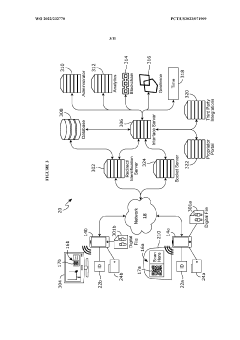Dolby Vision's Influence on Personalized Content Creation
JUL 30, 20258 MIN READ
Generate Your Research Report Instantly with AI Agent
Patsnap Eureka helps you evaluate technical feasibility & market potential.
Dolby Vision Evolution
Dolby Vision has undergone a remarkable evolution since its inception, transforming the landscape of content creation and consumption. Initially introduced as a high dynamic range (HDR) imaging technology in 2014, Dolby Vision has continuously expanded its capabilities and applications, becoming a cornerstone of personalized content creation.
The early stages of Dolby Vision focused primarily on enhancing the visual quality of content for cinema and high-end televisions. It offered superior color depth, brightness, and contrast compared to standard dynamic range (SDR) formats. This breakthrough allowed content creators to capture and display a wider range of colors and luminance levels, resulting in more lifelike and immersive viewing experiences.
As the technology matured, Dolby Vision expanded beyond traditional film and television applications. It found its way into mobile devices, gaming consoles, and streaming platforms, democratizing access to high-quality visual content. This expansion marked a significant shift in how content could be personalized and optimized for various viewing environments and devices.
The introduction of Dolby Vision IQ in 2020 represented a major leap forward in personalized content delivery. This intelligent feature dynamically adjusts content based on the ambient light conditions of the viewing environment, ensuring optimal picture quality regardless of the surroundings. This advancement demonstrated Dolby's commitment to enhancing the viewer's experience through adaptive technologies.
In recent years, Dolby Vision has increasingly focused on empowering content creators with tools for greater artistic expression. The development of Dolby Vision Creator Tools has allowed filmmakers, colorists, and post-production professionals to have more precise control over the visual elements of their content. This suite of tools enables the creation of multiple versions of content optimized for different viewing scenarios, furthering the personalization of the viewing experience.
The evolution of Dolby Vision has also seen integration with artificial intelligence and machine learning technologies. These advancements have paved the way for more sophisticated content analysis and optimization, allowing for real-time adjustments to enhance visual quality based on the specific characteristics of the content being displayed.
As Dolby Vision continues to evolve, it is increasingly focusing on personalized content creation at scale. The technology now supports workflows that enable efficient production of content variants tailored to different audience segments, viewing devices, and environmental conditions. This shift towards mass personalization represents a significant departure from the one-size-fits-all approach to content distribution, offering viewers a more tailored and engaging experience across a wide range of platforms and devices.
The early stages of Dolby Vision focused primarily on enhancing the visual quality of content for cinema and high-end televisions. It offered superior color depth, brightness, and contrast compared to standard dynamic range (SDR) formats. This breakthrough allowed content creators to capture and display a wider range of colors and luminance levels, resulting in more lifelike and immersive viewing experiences.
As the technology matured, Dolby Vision expanded beyond traditional film and television applications. It found its way into mobile devices, gaming consoles, and streaming platforms, democratizing access to high-quality visual content. This expansion marked a significant shift in how content could be personalized and optimized for various viewing environments and devices.
The introduction of Dolby Vision IQ in 2020 represented a major leap forward in personalized content delivery. This intelligent feature dynamically adjusts content based on the ambient light conditions of the viewing environment, ensuring optimal picture quality regardless of the surroundings. This advancement demonstrated Dolby's commitment to enhancing the viewer's experience through adaptive technologies.
In recent years, Dolby Vision has increasingly focused on empowering content creators with tools for greater artistic expression. The development of Dolby Vision Creator Tools has allowed filmmakers, colorists, and post-production professionals to have more precise control over the visual elements of their content. This suite of tools enables the creation of multiple versions of content optimized for different viewing scenarios, furthering the personalization of the viewing experience.
The evolution of Dolby Vision has also seen integration with artificial intelligence and machine learning technologies. These advancements have paved the way for more sophisticated content analysis and optimization, allowing for real-time adjustments to enhance visual quality based on the specific characteristics of the content being displayed.
As Dolby Vision continues to evolve, it is increasingly focusing on personalized content creation at scale. The technology now supports workflows that enable efficient production of content variants tailored to different audience segments, viewing devices, and environmental conditions. This shift towards mass personalization represents a significant departure from the one-size-fits-all approach to content distribution, offering viewers a more tailored and engaging experience across a wide range of platforms and devices.
Market Demand Analysis
The market demand for Dolby Vision in personalized content creation has been steadily growing, driven by the increasing consumer appetite for high-quality, immersive visual experiences. As viewers become more discerning, there is a rising expectation for content that not only looks spectacular but also adapts to individual preferences and viewing environments.
The adoption of Dolby Vision technology in content creation has been particularly strong in the streaming and home entertainment sectors. Major streaming platforms have embraced Dolby Vision as a differentiator, offering viewers enhanced color, contrast, and brightness in their content libraries. This has created a ripple effect, encouraging content creators to produce more Dolby Vision-compatible material to meet the demands of these platforms and their audiences.
In the film and television industry, there has been a noticeable shift towards Dolby Vision for both production and post-production processes. Cinematographers and colorists are leveraging the technology to achieve more precise color grading and to ensure their creative vision is accurately preserved across various display devices. This trend is expected to continue as more production houses invest in Dolby Vision-capable equipment and workflows.
The gaming industry has also shown significant interest in Dolby Vision technology. With the rise of next-generation gaming consoles and high-end PC graphics cards, gamers are seeking more visually stunning and immersive experiences. Game developers are responding by incorporating Dolby Vision into their titles, enhancing the visual fidelity and dynamic range of their games.
The personalization aspect of Dolby Vision is particularly appealing in the context of smart TVs and mobile devices. Consumers are increasingly looking for content that adapts to their specific viewing conditions, such as ambient light levels and display capabilities. This has led to a growing demand for Dolby Vision IQ, which automatically optimizes picture settings based on the content and viewing environment.
In the automotive sector, there is an emerging market for Dolby Vision in in-car entertainment systems. As vehicles become more autonomous, the demand for high-quality video experiences for passengers is expected to rise, creating new opportunities for Dolby Vision implementation.
The education and professional training sectors are also showing interest in Dolby Vision for creating more engaging and realistic visual content. This is particularly relevant in fields such as medical imaging, architectural visualization, and remote learning, where accurate color reproduction and high dynamic range can significantly enhance the learning experience.
As the market for personalized content continues to expand, the demand for Dolby Vision is likely to grow across various industries. Content creators and technology providers are expected to invest more in Dolby Vision-compatible tools and workflows to meet this demand, further driving innovation in the field of personalized visual experiences.
The adoption of Dolby Vision technology in content creation has been particularly strong in the streaming and home entertainment sectors. Major streaming platforms have embraced Dolby Vision as a differentiator, offering viewers enhanced color, contrast, and brightness in their content libraries. This has created a ripple effect, encouraging content creators to produce more Dolby Vision-compatible material to meet the demands of these platforms and their audiences.
In the film and television industry, there has been a noticeable shift towards Dolby Vision for both production and post-production processes. Cinematographers and colorists are leveraging the technology to achieve more precise color grading and to ensure their creative vision is accurately preserved across various display devices. This trend is expected to continue as more production houses invest in Dolby Vision-capable equipment and workflows.
The gaming industry has also shown significant interest in Dolby Vision technology. With the rise of next-generation gaming consoles and high-end PC graphics cards, gamers are seeking more visually stunning and immersive experiences. Game developers are responding by incorporating Dolby Vision into their titles, enhancing the visual fidelity and dynamic range of their games.
The personalization aspect of Dolby Vision is particularly appealing in the context of smart TVs and mobile devices. Consumers are increasingly looking for content that adapts to their specific viewing conditions, such as ambient light levels and display capabilities. This has led to a growing demand for Dolby Vision IQ, which automatically optimizes picture settings based on the content and viewing environment.
In the automotive sector, there is an emerging market for Dolby Vision in in-car entertainment systems. As vehicles become more autonomous, the demand for high-quality video experiences for passengers is expected to rise, creating new opportunities for Dolby Vision implementation.
The education and professional training sectors are also showing interest in Dolby Vision for creating more engaging and realistic visual content. This is particularly relevant in fields such as medical imaging, architectural visualization, and remote learning, where accurate color reproduction and high dynamic range can significantly enhance the learning experience.
As the market for personalized content continues to expand, the demand for Dolby Vision is likely to grow across various industries. Content creators and technology providers are expected to invest more in Dolby Vision-compatible tools and workflows to meet this demand, further driving innovation in the field of personalized visual experiences.
Technical Challenges
Dolby Vision's influence on personalized content creation presents several technical challenges that need to be addressed. One of the primary obstacles is the complexity of implementing High Dynamic Range (HDR) and Wide Color Gamut (WCG) technologies across diverse display devices. The variability in hardware capabilities, from high-end televisions to mobile devices, makes it difficult to ensure consistent visual quality across all platforms.
Another significant challenge lies in the data processing and storage requirements for Dolby Vision content. The increased color depth and luminance range result in larger file sizes, which can strain existing infrastructure and increase costs for content creators and distributors. This issue is particularly pronounced when considering the need for real-time personalization, which requires rapid processing and delivery of customized content.
The integration of Dolby Vision with existing content creation workflows poses additional hurdles. Many production tools and software suites are not yet fully compatible with Dolby Vision's specifications, necessitating updates or replacements. This transition can be time-consuming and expensive for content creators, potentially slowing down adoption rates.
Personalization itself introduces a layer of complexity to the content creation process. Adapting Dolby Vision content in real-time to suit individual viewer preferences or environmental conditions requires sophisticated algorithms and processing power. Balancing the desire for personalization with the need to maintain the creator's artistic intent is a delicate technical challenge that demands careful consideration.
Furthermore, the bandwidth requirements for streaming Dolby Vision content, especially when combined with personalization features, can be substantial. This puts pressure on network infrastructure and may lead to buffering or quality degradation issues for users with limited internet speeds. Developing efficient compression techniques that preserve the visual fidelity of Dolby Vision while reducing data transmission needs is an ongoing technical challenge.
Lastly, ensuring backward compatibility with Standard Dynamic Range (SDR) displays and content is crucial for widespread adoption. Creating a seamless experience that leverages Dolby Vision's capabilities on supported devices while still providing high-quality visuals on legacy systems requires complex tone-mapping algorithms and careful content mastering processes.
Another significant challenge lies in the data processing and storage requirements for Dolby Vision content. The increased color depth and luminance range result in larger file sizes, which can strain existing infrastructure and increase costs for content creators and distributors. This issue is particularly pronounced when considering the need for real-time personalization, which requires rapid processing and delivery of customized content.
The integration of Dolby Vision with existing content creation workflows poses additional hurdles. Many production tools and software suites are not yet fully compatible with Dolby Vision's specifications, necessitating updates or replacements. This transition can be time-consuming and expensive for content creators, potentially slowing down adoption rates.
Personalization itself introduces a layer of complexity to the content creation process. Adapting Dolby Vision content in real-time to suit individual viewer preferences or environmental conditions requires sophisticated algorithms and processing power. Balancing the desire for personalization with the need to maintain the creator's artistic intent is a delicate technical challenge that demands careful consideration.
Furthermore, the bandwidth requirements for streaming Dolby Vision content, especially when combined with personalization features, can be substantial. This puts pressure on network infrastructure and may lead to buffering or quality degradation issues for users with limited internet speeds. Developing efficient compression techniques that preserve the visual fidelity of Dolby Vision while reducing data transmission needs is an ongoing technical challenge.
Lastly, ensuring backward compatibility with Standard Dynamic Range (SDR) displays and content is crucial for widespread adoption. Creating a seamless experience that leverages Dolby Vision's capabilities on supported devices while still providing high-quality visuals on legacy systems requires complex tone-mapping algorithms and careful content mastering processes.
Current Implementation
01 Personalized content delivery based on user preferences
Systems and methods for delivering personalized content using Dolby Vision technology. This involves analyzing user preferences, viewing habits, and device capabilities to tailor the content's visual characteristics, such as brightness, contrast, and color, to individual viewers. The personalization enhances the viewing experience by optimizing the content for each user's specific needs and preferences.- Personalized content delivery based on user preferences: Systems and methods for delivering personalized content using Dolby Vision technology. This involves analyzing user preferences, viewing habits, and device capabilities to tailor the content's visual quality, brightness, and color settings for an optimized viewing experience.
- Dynamic HDR metadata adjustment for Dolby Vision: Techniques for dynamically adjusting High Dynamic Range (HDR) metadata in Dolby Vision content based on viewing conditions and display capabilities. This allows for real-time optimization of content appearance across different devices and environments.
- Content-aware encoding for Dolby Vision: Methods for intelligent encoding of Dolby Vision content that adapts to the specific characteristics of the video material. This approach optimizes compression efficiency while preserving the high-quality visual experience associated with Dolby Vision.
- User interface for Dolby Vision personalization: Development of intuitive user interfaces that allow viewers to customize their Dolby Vision experience. These interfaces provide controls for adjusting various parameters of the video output, enabling users to fine-tune the content to their personal preferences.
- Cross-device content synchronization with Dolby Vision: Systems for synchronizing Dolby Vision content and personalized settings across multiple devices. This ensures a consistent viewing experience as users switch between different screens, maintaining their preferred visual settings and content progress.
02 Dynamic adjustment of HDR content
Techniques for dynamically adjusting High Dynamic Range (HDR) content in Dolby Vision to suit different viewing environments and display capabilities. This includes real-time modification of metadata to optimize the content's appearance across various devices and lighting conditions, ensuring consistent quality and viewer satisfaction.Expand Specific Solutions03 Content-aware encoding and compression
Advanced encoding and compression methods specifically designed for Dolby Vision content. These techniques analyze the visual characteristics of the content to determine optimal compression strategies, preserving image quality while reducing bandwidth requirements. This enables efficient streaming and storage of high-quality personalized content.Expand Specific Solutions04 Adaptive streaming for personalized Dolby Vision content
Implementation of adaptive streaming technologies tailored for Dolby Vision personalized content. This involves dynamically adjusting the bitrate and resolution of the content based on network conditions and device capabilities, ensuring smooth playback and optimal visual quality for each user's specific viewing setup.Expand Specific Solutions05 User interface for content personalization
Development of intuitive user interfaces that allow viewers to customize their Dolby Vision content experience. These interfaces provide options for adjusting visual parameters, creating viewing profiles, and setting preferences for different types of content or viewing scenarios, enhancing user engagement and satisfaction with personalized content.Expand Specific Solutions
Key Industry Players
The competitive landscape for Dolby Vision's influence on personalized content creation is evolving rapidly, reflecting the industry's early growth stage. The market size is expanding as more content creators and streaming platforms adopt this technology. While still maturing, Dolby Vision's technical sophistication is advancing, with companies like Huawei, Samsung, and Intel investing in compatible hardware. Established players such as Dolby Laboratories Licensing Corp. are leading innovation, while tech giants like Apple and Amazon are integrating Dolby Vision into their ecosystems. This dynamic environment suggests significant potential for growth and innovation in personalized content experiences.
Huawei Technologies Co., Ltd.
Technical Solution: Huawei has developed its own HDR Vivid technology, which competes with Dolby Vision in the realm of personalized content creation. HDR Vivid uses AI algorithms to analyze and optimize each frame of video content, enhancing contrast, color, and clarity[13]. The technology adapts to different display capabilities and viewing environments, ensuring consistent quality across devices. Huawei's approach includes real-time scene detection and content-aware optimization, allowing for dynamic adjustments based on the specific characteristics of each scene[14]. The company has also integrated this technology into its mobile devices, enabling on-device HDR enhancement for both captured and viewed content, thus extending personalized content creation to mobile platforms[15].
Strengths: Strong integration with mobile devices, AI-driven optimization, potential for widespread adoption in emerging markets. Weaknesses: Limited adoption outside of Huawei ecosystem, potential geopolitical challenges affecting global market penetration.
Koninklijke Philips NV
Technical Solution: Philips has been at the forefront of HDR technology development, particularly with its HDR Perfect system. This technology uses local dimming and bright peak highlights to enhance contrast and color accuracy[7]. Philips' Ambilight technology, which extends the on-screen colors to the surrounding wall, offers a unique approach to personalized content creation by expanding the viewing experience beyond the screen[8]. The company has also developed P5 AI Intelligent Dual Picture Engine, which uses neural networks to analyze and optimize picture quality in real-time, adapting to both content and viewing conditions[9]. This AI-driven approach allows for dynamic personalization of content based on individual preferences and environmental factors.
Strengths: Innovative Ambilight technology for immersive viewing, strong AI integration for picture optimization, established presence in the TV market. Weaknesses: Ambilight technology limited to Philips TVs, potentially higher cost for consumers.
Core Dolby Vision Tech
Personalized content creation using neural networks
PatentActiveUS11501079B1
Innovation
- A dynamic content generation system utilizing a trained artificial neural network to create personalized derivative stories by modifying existing content, incorporating elements from various sources, formats, and lengths, allowing for radical changes or combinations to suit consumer preferences, while ensuring compliance with metadata constraints and royalty tracking for copyrighted materials.
Delivery of dynamic content based upon predetermined thresholds
PatentWO2022232770A1
Innovation
- A system that delivers content to users only when a predetermined threshold is met, utilizing machine-readable codes (MRCs) to identify user devices and provide customized, unique content based on user interactions, location, and other data points, ensuring maximum impact when a sufficient audience is reached.
Content Creation Impact
Dolby Vision's impact on content creation has been transformative, ushering in a new era of personalized and immersive viewing experiences. This advanced HDR technology has empowered creators to push the boundaries of visual storytelling, enabling them to capture and deliver content with unprecedented color depth, contrast, and brightness.
The introduction of Dolby Vision has significantly altered the creative process for filmmakers, cinematographers, and post-production teams. It has expanded the palette of visual tools available, allowing for more nuanced and expressive imagery. Creators can now work with a wider color gamut and higher dynamic range, resulting in more lifelike and visually striking content that closely mirrors the human visual experience.
One of the most significant impacts of Dolby Vision on content creation is the ability to tailor content for different viewing environments and devices. This technology enables creators to produce a single master that can be optimized for various display capabilities, from high-end cinema screens to consumer-grade televisions and mobile devices. This flexibility ensures that the creator's vision is preserved across different viewing platforms, maintaining the intended visual impact regardless of the display technology.
The adoption of Dolby Vision has also led to changes in production workflows. Cinematographers and colorists now have to consider the expanded capabilities of HDR throughout the entire production process, from capture to post-production. This has necessitated new skills and techniques in lighting, color grading, and visual effects to fully leverage the technology's potential.
Furthermore, Dolby Vision has influenced the way stories are told visually. The enhanced contrast and color capabilities allow for more subtle visual cues and atmospheric elements, enabling creators to convey mood and emotion with greater precision. This has led to a more immersive and engaging viewing experience, where the visual elements play an even more crucial role in storytelling.
The technology has also sparked innovation in content creation tools and software. Manufacturers of cameras, monitors, and post-production equipment have developed new products specifically designed to support Dolby Vision workflows. This has created a ripple effect throughout the industry, driving advancements in related technologies and fostering a more dynamic and innovative content creation ecosystem.
The introduction of Dolby Vision has significantly altered the creative process for filmmakers, cinematographers, and post-production teams. It has expanded the palette of visual tools available, allowing for more nuanced and expressive imagery. Creators can now work with a wider color gamut and higher dynamic range, resulting in more lifelike and visually striking content that closely mirrors the human visual experience.
One of the most significant impacts of Dolby Vision on content creation is the ability to tailor content for different viewing environments and devices. This technology enables creators to produce a single master that can be optimized for various display capabilities, from high-end cinema screens to consumer-grade televisions and mobile devices. This flexibility ensures that the creator's vision is preserved across different viewing platforms, maintaining the intended visual impact regardless of the display technology.
The adoption of Dolby Vision has also led to changes in production workflows. Cinematographers and colorists now have to consider the expanded capabilities of HDR throughout the entire production process, from capture to post-production. This has necessitated new skills and techniques in lighting, color grading, and visual effects to fully leverage the technology's potential.
Furthermore, Dolby Vision has influenced the way stories are told visually. The enhanced contrast and color capabilities allow for more subtle visual cues and atmospheric elements, enabling creators to convey mood and emotion with greater precision. This has led to a more immersive and engaging viewing experience, where the visual elements play an even more crucial role in storytelling.
The technology has also sparked innovation in content creation tools and software. Manufacturers of cameras, monitors, and post-production equipment have developed new products specifically designed to support Dolby Vision workflows. This has created a ripple effect throughout the industry, driving advancements in related technologies and fostering a more dynamic and innovative content creation ecosystem.
Ecosystem Integration
Dolby Vision's integration into the content creation ecosystem has been transformative, fostering a more interconnected and efficient workflow for personalized content production. This integration has led to the development of specialized tools and software that seamlessly incorporate Dolby Vision capabilities throughout the content creation pipeline.
At the capture stage, camera manufacturers have embraced Dolby Vision technology, embedding it directly into their hardware. This allows cinematographers and content creators to visualize and capture high dynamic range (HDR) content in real-time, ensuring that the creative intent is preserved from the outset. Post-production software suites have also evolved to support Dolby Vision, enabling colorists and editors to work with the expanded color and brightness ranges offered by the technology.
The ecosystem integration extends to content delivery platforms and streaming services, which have adapted their infrastructure to support Dolby Vision content. This end-to-end integration ensures that the personalized content created using Dolby Vision maintains its quality and creative intent across various distribution channels and viewing devices.
Dolby has fostered partnerships with major technology providers, including Apple, LG, and Sony, to ensure widespread compatibility and support for Dolby Vision across devices. This collaborative approach has resulted in a more cohesive ecosystem, where content creators can be confident that their work will be accurately displayed on a wide range of consumer devices.
The integration of Dolby Vision into cloud-based workflows has further enhanced the ecosystem's efficiency. Cloud platforms now offer Dolby Vision-enabled rendering and encoding services, allowing for scalable and distributed content creation processes. This has been particularly beneficial for personalized content creation, as it enables rapid iteration and customization of content for different audience segments.
Furthermore, the ecosystem integration has spurred the development of AI-powered tools that leverage Dolby Vision's capabilities. These tools can analyze and optimize content for different viewing environments and personal preferences, enhancing the personalization aspect of content creation. This synergy between AI and Dolby Vision technology is opening new avenues for creating tailored viewing experiences at scale.
As the ecosystem continues to mature, we are seeing increased standardization and interoperability between different tools and platforms that support Dolby Vision. This standardization is crucial for streamlining workflows and reducing friction in the content creation process, ultimately leading to more efficient and cost-effective production of personalized content.
At the capture stage, camera manufacturers have embraced Dolby Vision technology, embedding it directly into their hardware. This allows cinematographers and content creators to visualize and capture high dynamic range (HDR) content in real-time, ensuring that the creative intent is preserved from the outset. Post-production software suites have also evolved to support Dolby Vision, enabling colorists and editors to work with the expanded color and brightness ranges offered by the technology.
The ecosystem integration extends to content delivery platforms and streaming services, which have adapted their infrastructure to support Dolby Vision content. This end-to-end integration ensures that the personalized content created using Dolby Vision maintains its quality and creative intent across various distribution channels and viewing devices.
Dolby has fostered partnerships with major technology providers, including Apple, LG, and Sony, to ensure widespread compatibility and support for Dolby Vision across devices. This collaborative approach has resulted in a more cohesive ecosystem, where content creators can be confident that their work will be accurately displayed on a wide range of consumer devices.
The integration of Dolby Vision into cloud-based workflows has further enhanced the ecosystem's efficiency. Cloud platforms now offer Dolby Vision-enabled rendering and encoding services, allowing for scalable and distributed content creation processes. This has been particularly beneficial for personalized content creation, as it enables rapid iteration and customization of content for different audience segments.
Furthermore, the ecosystem integration has spurred the development of AI-powered tools that leverage Dolby Vision's capabilities. These tools can analyze and optimize content for different viewing environments and personal preferences, enhancing the personalization aspect of content creation. This synergy between AI and Dolby Vision technology is opening new avenues for creating tailored viewing experiences at scale.
As the ecosystem continues to mature, we are seeing increased standardization and interoperability between different tools and platforms that support Dolby Vision. This standardization is crucial for streamlining workflows and reducing friction in the content creation process, ultimately leading to more efficient and cost-effective production of personalized content.
Unlock deeper insights with Patsnap Eureka Quick Research — get a full tech report to explore trends and direct your research. Try now!
Generate Your Research Report Instantly with AI Agent
Supercharge your innovation with Patsnap Eureka AI Agent Platform!
